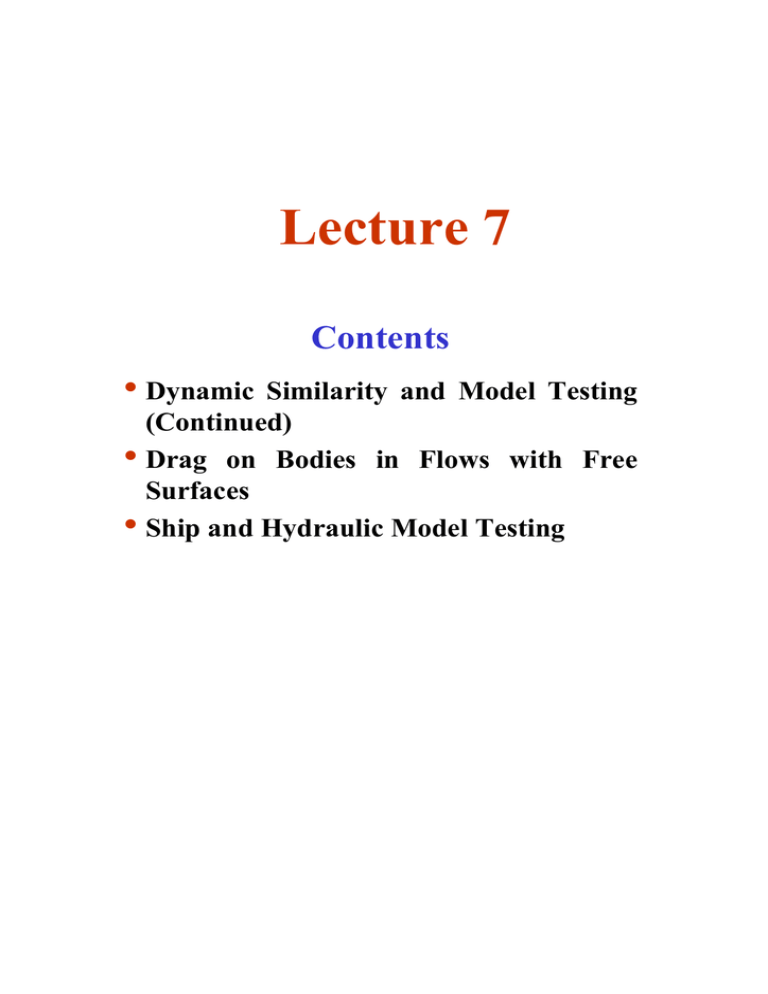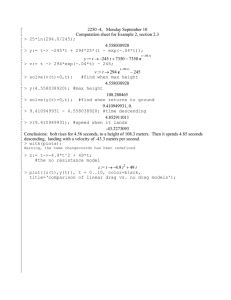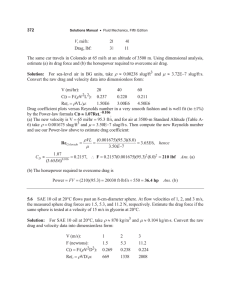Lecture 7 • Contents
advertisement

Lecture 7
Contents
• Dynamic Similarity and Model Testing
(Continued)
• Drag on Bodies in Flows with Free
Surfaces
• Ship and Hydraulic Model Testing
What Did We Do In Last Lecture?
1 page for Drag as
function of 2 variables
(e.g. velocity and
diameter)
d increases
from curve
to curve
1 page for
each value
of ρ
1 book for Drag as
function of 2 variables
(e.g. velocity, diameter,
density)
Shelf of books for Drag as
a function of 4 variables
(velocity, diameter,
density, viscosity)
If we want 10 data points per curve, at £10 each
experiment, this will cost...
10 × 10 × 10 × 10 × £10 = £100,000
THERE MUST BE
A BETTER WAY !?!?
What Did We Do In Last Lecture?
α
β
D ∝ V ⋅ d ⋅µ
ML T
−2
=
(L T )
−1 α
(L )
β
γ
(ML
−1
T
STOKES’ LAW
Recall, only valid for low Re!
D = const × V d µ
DRAG COEFFICIENT CD
Drag
CD =
2
ρ 2 ⎛d ⎞
V∞ π ⎜ ⎟
2
⎝2⎠
)
−1 γ
What Did We Do In Last Lecture?
For a body in a homogeneous fluid:
CD(Re)
CD
Re =
Vd
ν
• Model Testing requires…
• Dynamic Similarity
Need…
(CD)Model=(CD)Prototype
and hence need …
ReModel=RePrototype
Dynamic Similarity and Model Testing
What are the required conditions for
model experiments?
• Want to test scale model of a prototype in wind tunnel.
• Question: Why would any of the measured model data be of any
LAST SLIDE FROM
PREVIOUS LECTURE
relevance to the prototype? After all they are of different size!
• So, what conditions need to be satisfied such that wind tunnel data
tell us anything about the prototype?
One Needs:
•Geometric Similarity
Model has the same shape as prototype
•Kinematic Similarity
Additionally it is required that ...
Fluid Velocity For Model
at corresponding points = Const.
Fluid Velocity For Prototype
•Dynamic Similarity
Additionally to Geo. Sim. and Kin. Sim. it is required
that: Non.-dimensional forces are the same for model and
prototype, e.g. ...
(C D )m = (C D ) p
Know that for body in homogeneous fluid drag coefficient is
function of Re number o-n-l-y. Hence, Dyn. Sim. only possible if
(Re )m = (Re ) p
Dyn, Sim. Hard
to achieve!
Example:
We want to test a one-fifth scale model in a wind
tunnel under dynamically similar conditions.
• Prototype Aircraft: V = 100 m (≈ 0.3 × Speed of Sound )
s
Lp
1
• Model Aircraft:
Scale → Lm =
5
5
• Assume same air properties for model and prototype
Dynamic Similarity Requires:
(Re )m = (Re ) p
Vm =
Vm Lm
ν
=
Vp Lp
ν
Lp
V p = 5 ×100 m = 500 m
Lm
s
s
= SUPERSONIC
!!!
But at supersonic flow speed whole fluid dynamics are
different. One gets shocks etc. Will learn about this next year!
Hence, in order to achieve dynamic similarity without
encountering this problem ...
• … one needs a huge wind tunnel (such that one can make
VmLm large to get large Rem)
• … which can be pressurized (such that one can make
νkkkkkk
= µ ρ small, which also increases Rem)
Photos of Wind Tunnels and Models in Wind Tunnels
Continued...
The world’s largest wind tunnel
( a 10-storey building) at NASA Ames ...
… and a not-so-large wind tunnel.
Drag on Bodies in Flows with Free Surfaces
• In all previous sections when we considered drag on body
assumption was we are dealing with bodies in homogeneous fluid.
• Now we will look at the more general case when we have a free
surface, as for instance, illustrated in the following sketch...
Air
V
Free
Surface
L
Air
Water
Air
Now we cannot neglect body forces (gravity).
Consequently have to assume ...
C D = F (V , d , µ , ρ , g )
1424
3{
As Before New
• Following
arguments in section ‘Bodies Moving in
Homogeneous Fluids’ the drag coefficient, CD, now depends on
two dimensionless groups, i.e. Re + Another...
Inspections shows that simplest way to make g
dimensionless is ...
gL
V2
m
m
2
Units: s 2
⎛m⎞
⎜ ⎟
⎝s⎠
Continued...
Traditionally one uses instead ...
FROUDE NUMBER: Fr =
So ...
V
gL
CD = F (Re, Fr )
Dynamic similarity requires ...
(Re )m = (Re ) p AND (Fr )m = (Fr ) p
The Froude number is a dimensionless number
which expresses the ratio of INERTIA FORCE
and BODY FORCE.
It is important, for instance, when one considers
flows with free surfaces and wave generation.
Ship and Hydraulic Model Testing
• One has free surface flow. Hence, dynamic similarity requires
Rem=Rep AND Frm=Frp
• We found earlier that one already gets into tough problems when
one only has to satisfy the single condition Rem=Rep . Hence, we do
not expect things to get simpler now...
Let’s try to test a model ship!
•Recall ...
Re =
VL
ν
with ν =
µ
,
ρ
Fr =
V
gL
• If water used for model and prototype then ...
µm = µ p , ρm = ρ p
⇒ νm =ν p
• For dynamic similarity want ...
(Re )m = (Re ) p
Requires
Vm Lm = V p L p
2
Vm2 V p
=
Lm L p
(Fr )m = (Fr ) p
From (I)
Lm =
Vp Lp
Vm
Substituting (III)
into (II)
gives ...
(I)
(II)
(III)
Continued...
V p2
Vm2
=
Vp Lp
Lp
Vm
Vm3 = V p3
Vm = V p
And because of Eq. (II) ...
2
Vm2 V p
=
Lm L p
… then also ...
(2) - repeated
Lm = L p
So, in order to carry out model test that satisfies
dynamic similarity need model with same size as
prototype and test it at same velocity prototype
will be exposed to.
In other words,…
DYNAMIC SIMILARITY IS NOT
PRACTICALLY ACHIEVABLE!
Continued...
• To overcome this problem Froude proposed to write ...
CD
TOTAL
DRAG
C DF (Re )
=
+
SKIN FRICTION
DRAG
C DW (Fr ) (A)
WAVE
DRAG
• Skin friction drag assumed to be a function of
Reynolds number o-n-l-y
• Wave
drag assumed to be a function of
Froude number o-n-l-y
HOW / WHY DOES ONE PROFIT FROM THIS?
• To get
(CD )m = (CD )p
W
one requires ...
W
Frm = Frp
...since wave drag is function of Fr o-n-l-y.
But (B) is easy to achieve;
simply ensure that ...
(B)
Continued...
Frm = Frp
Vm
=
g Lm
2
Vm2 V p
=
Lm L p
Vp
g Lp
2
⎛ Vp ⎞
L p = ⎜⎜ ⎟⎟ Lm
⎝ Vm ⎠
Example: If … Vm =
1
V p one gets ...
10
2
⎛
⎞
⎜ Vp ⎟
⎟ Lm
Lp = ⎜
1
⎜⎜ V ⎟⎟
p
⎝ 10 ⎠
Lm =
= 100 Lm
1
Lp
100
Thus, if we use a 1/100-scale model then
the velocity in our model experiment has
to be 1/10th of the prototype speed.
Continued...
• From Froude’s assumption of Eq.(A) ...
C D = C DF (Re ) + C DW (Fr )
Prototype
Model
(CD )p = CD − (CD )p
(CD )m = CD − (CD )m
W
m
W
F
Since ...
(A) -repeated
p
F
(CD )m = (CD )p
W
W
… which is so because designed experiment
such that Froude numbers are equal.
(
)
(
)
C Dm − C DF = C D p − C DF
m
p
CD p
123
=
C Dm +
[ (CD )P − (CD )m ]
F
F
123
1444
424444
3
Measured in
model tests
Calculated
Total Drag
Total Drag Difference between Skin. Fric. Drag
Coeff. Prototype Coeff. Model
Coeff. of Protot. and Model
• A similar approach is used for hydraulic modeling in civil
engineering
• NOTE the essential role of theory in experiments!
Photos of Models in Civil Engineering
River Model
Napier Harbour
Model, Hydraulic
Research Station,
Wallingford,
Oxfordshire
Undistorted model of
the Van der Kloof
Dam (Orange River)
Continued...
Rotating-Tank Facility at L.E.G.I., Grenoble
This facility is used to investigate the influence of
background rotation (Coriolis Force arising from rotation
of the earth) on large-scale geophysical flows in oceans.
The diameter of the rotating tank is 13 metres!
The facility was built in the early 1960s when engineers
wanted to investigate possible effects of a planned tidal
power plant in the north of France on
flows in the channel.
Example: Application of Froude’s Assumption in Ship
Modeling, Greek Trireme
Calculate power required for ancient Greek warship.
How many oarsman are needed?
•Prototype:
Length = 30 m, Wetted Surface Area = 320m 2 , Speed = 5 ms−1
•Model:
1
− scale
10
Model Test Data
•Water:
Density ρ = 1000 kg m-3 , Dynamic Viscosity µ = 0.001Nsm − 2
• Also
given is: Prandtl-Schlichting Formula for skinfriction drag of a flat plate.
CDF =
0.455
(log10 Re L )2.58
: Re L > 3 × 106
Empirical equation obtained from least-squares fit to large number
of experimental data points. Assume you found this in book (e.g.
Schlichting, 1987, Boundary-Layer Theory, 7th ed., Mc-Graw
Hill)
Continued...
Outline of strategy to solve the problem
(A) Calculate Froude number for prototype. Use necessary
condition for equal Froude numbers to infer model flow
speed.
(B) Determine corresponding model drag from table/plot of
model-test data.
(C) Calculate Reynolds number for model and prototype
(D) Use the Prandtl-Schlichting formula for coefficient of
skin-friction drag to calculate its values for model and
prototype.
(E) Calculate coefficient of wave drag for model (=wave
drag of prototype since equal Fr numbers) using
Froude’s assumption (Tot.Drag= Wave Drag+Skin Fric.
Drag). Use the result to calculate total drag coefficient
for prototype.
(F) Calculate drag and power required for prototype.
MAKE
ASSUMPTION
ABOUT
OARSMEN
(strokes/min; length oar handle, pull of oarsmen on
handle etc.). Use these to calculate number of oarsmen
(G) Work per stroke done by each oarsman
(H) Power and useful power generated by each oarsman
(I)
Obtain an estimate for the number of oarsmen required
to propel the ship at the assumed velocity
Continued...
Solution:
(A) Calculate Froude number for prototype. Use necessary
condition for equal Froude numbers to infer model flow
speed.
m
Vp
Frp =
Since ...
⇒
gL p
=
9.81
Frp = Frm
Vm =
5
s
m
s
2
= 0.29
30 m
Vp
⇒
Lm
Vp =
Lp
gL p
=
Vm
gLm
m
1 m
5 = 1.58
s
10 s
(B) Determine model drag corresponding to Vm from table/plot of
model-test data (see graph next slide).
Dm = 22.4 N
⇒
Total Drag Coefficient of model then...
⇒ C D = 22.4 N
m
1
ρ Vm2 Am
2
=
22.4 N
(
1
kg
1000 3 (1.58 m )2 0.01 × 320 m 2
2
m
)
= 0.0056
Because 1/10th-scale model; so every length, L, reduced by
factor 0.1. Thus, area which is L2 reduced by 0.1x0.1=0.01
Continued...
•Plot of model-test data from previous slide ...
Continued...
(C) Calculate Reynolds number for model and prototype
Prototype:
Re p =
Vp Lp
ν
=
ρ Vp Lp
=
µ
Model:
Re m=
Vm Lm
ν
=
ρ Vm Lm
=
µ
kg m
5 30 m
3
s
m
Ns
0.001 2
m
= 150 × 106
kg
m
1
.
58
3m
s
m3
Ns
0.001 2
m
= 4.74 × 106
1000
1000
(D) Use given Prandtl-Schlichting formula for coefficient of skinfriction drag to calculate its values for model and prototype.
(This means we are assuming that skin-friction drag for ship is
the same/equal to that for a flat plate.)
Prototype:
(CD )p = (log
F
0.455
)
= 0.0020
(log10 4.74 ×10 )
= 0.0034
10 150 × 10
6 2.58
Model:
(CD )m =
F
0.455
6 2.58
Continued...
(E) Calculate coefficient of wave drag for model (=wave drag of
prototype since equal Fr numbers) using Froude’s assumption
(Tot.Drag= Wave Drag+Skin Fric. Drag). Use the result to
calculate total drag coefficient for prototype.
Since ...
Frm = Fr p
⇒
(CD w )m
=
(CD w )p
Solving the ‘Froude assumption’ for model for (C D w )
m
and introducing known values gives ...
(CDw )m = (CD )m − (CD F )m
= 0.0056 − 0.0034 = 0.0022
… and since … (C D w ) = (C D w ) = 0.0022 then...
m
p
(CD ) p = (CD w )p + (CD F )p
= 0.0022 + 0.0020 = 0.0042
Continued...
(F) Calculate drag and power required for prototype.
1
ρ V p2 Ap
2
2
1
kg ⎛ m ⎞
= 0.0042 1000 3 ⎜ 5 ⎟ 320 m 2 = 16.8 kN
2
m ⎝ s⎠
D p = CD p
PowerRequired = Force × Velocity
= D p V p = 16800
= 84000
kg m m
5
2
s
s
kg m 3
s
3
= 84 kW
ENTER OARSMEN ...
What we really want to know is …
How many oarsmen are required to
propel the ship at 5 m/s ?
ASSUME:
• Each oarsman performs 12 strokes per minute
• Each oarsman exerts a pull of 310 N on the oar handle
• Each oarsman pulls oar through an arc measuring 1m
• Efficiency with which oar converts strokes into useful
energy is 55%
Continued...
(G) Work per stroke done by each oarsman
Work = Force × Distance
= 310 N × 1 m = 310 J
(H) Power and useful power generated by each oarsman
Power = Rate Of Doing Work
= 310 J ×
12 Strokes
J
= 62 = 62 W
60 s
s
Useful Power =
= 0.55 × 62 W = 34.1 W
(G) Obtain estimate for number of oarsman required to propel
ship at assumed velocity of 5 m/s
Number of Oarsmen =
=
Total Power Required
Useful Power Per Oarsman
84000 W
≈ 2460
34.1 W
Does this answer sound realistic?
Continued...
• The number of 2469 oarsmen seems a bit high.
Revise
assumptions and go through calculations again …
• I found on www that the maximum speed of a trireme
was 7 knots...
1knot = 0.51
m
s
⇒
7 knots = 3.57
m
km
= 12.9
s
h
Hence, maximum speed was, in fact, lower than the
value of 5 m/s we assumed. Also, they probably wouldn’t
have been going at full speed all day long. I presume
that 0.25-0.35 x max. speed is a sustainable relaxed
travel speed for slaves on long-distance trips. Check
were the revised assumptions get you to ...
• On
www I also found that the actual number of
oarsmen on a trireme was 170 (in 3 files on each side)






